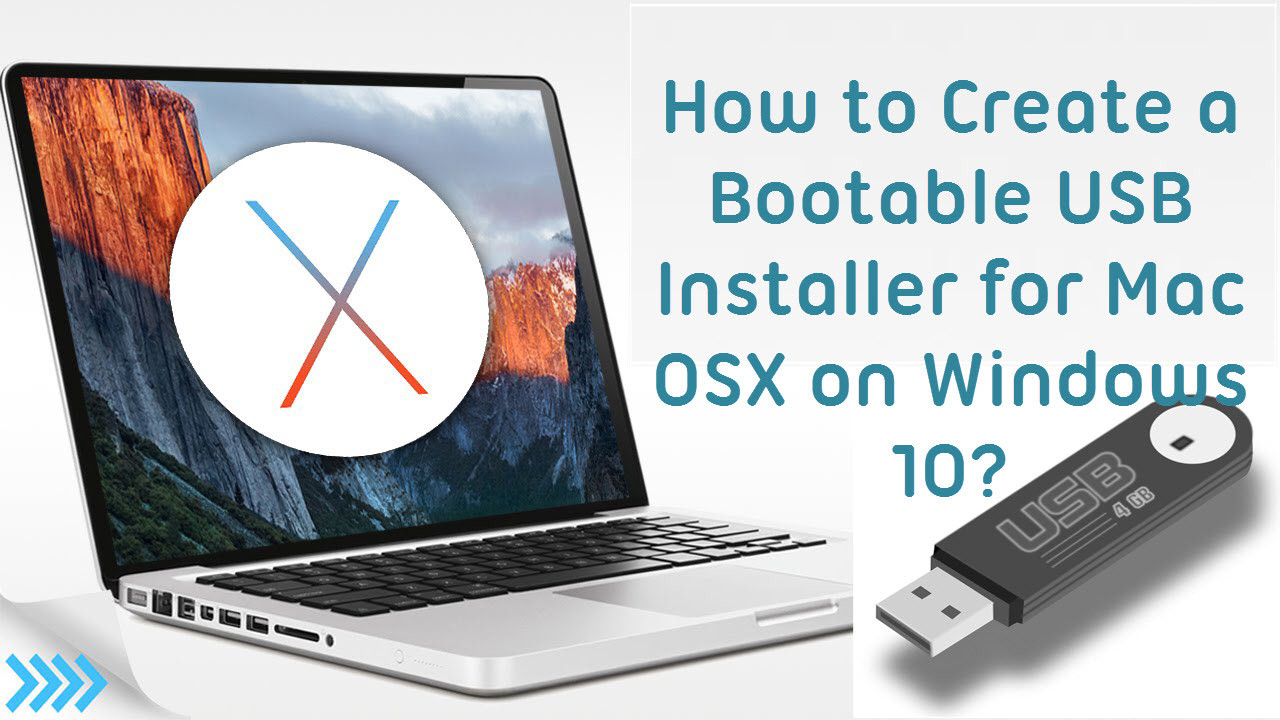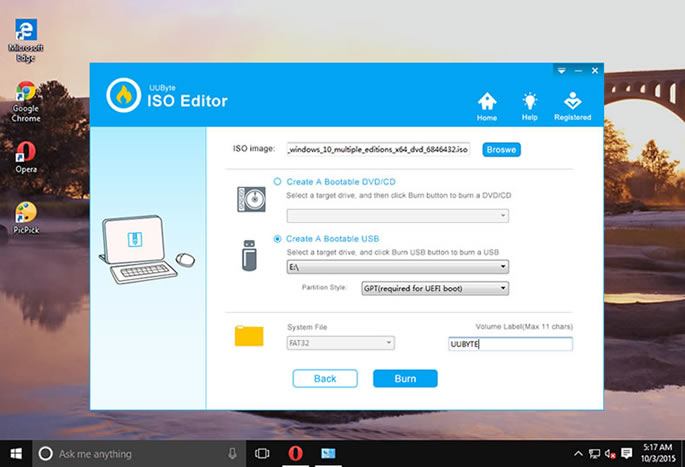© Provided by Windows Central
If i used this program to make a bootable usb will It works on mac or windows only or both? Blaine September 13, 2016 at 12:37 PM. Because i don’t know anyone has mac but only once with windows. Faiz Orz September 13, 2016 at 1:10 PM. Dear Blaine, This program helps you to create a bootable USB for Mac OS to install it on your PC (Laptop. Chances are high, you don’t have the Windows 10 installer disk with you, especially if you upgradedTips on making Bootable USB Drive for Windows 10 the easy way, you don't need technical boring.
Are you about to install Windows 10 on a UEFI-based device? This guide will show you how to create a compatible USB flash drive to complete the task.
When you have to install a clean copy of Windows 10, you'd typically use a USB media to boot the device into the 'Windows Setup' wizard to continue with the installation. However, if you have a computer that features a Unified Extensible Firmware Interface (UEFI), instead of the legacy Basic Input/Output System (BIOS), it's important to use the appropriate media for the motherboard firmware type.
On Windows 10, you can use at least two methods to create a bootable media to install the OS from USB on a UEFI-based computer. You can use the Microsoft Media Creation Tool to download the files onto a removable storage with support for both firmware types (UEFI and legacy BIOS). You can also use third-party tools, such as Rufus, which makes it easy to create a USB to install Windows with support for UEFI.
In this Windows 10 guide, we'll walk you through the steps to create a USB flash drive that includes UEFI support using the Microsoft Media Creation Tool and Rufus.
- How to create Windows 10 UEFI boot media using Media Creation Tool
- How to create Windows 10 UEFI boot media using Rufus tool
How to create Windows 10 UEFI boot media using Media Creation Tool
On devices using UEFI, the quickest way to create a bootable USB media to perform a clean install or in-place upgrade of Windows 10 is to use the Media Creation Tool, which Microsoft makes available for download through its support website.
To create a bootable media, connect a USB flash drive of at least 8GB of storage, and then use these steps:
- Open Windows 10 download page.
Under the 'Create Windows 10 installation media' section, click the Download tool now button to save the file on your computer.
© Provided by Windows Central- Double-click the MediaCreationToolxxxx.exe file to relaunch the tool.
- Click the Accept button to agree to the Microsoft terms.
Select the Create installation media (USB flash drive, DVD, or ISO file) for another PC option.
© Provided by Windows Central- Click the Next button.
(Optional) Clear the Use the recommended options for this PC option.
© Provided by Windows CentralSelect the correct language, architecture, and edition of Windows 10.
Quick tip: If you'll be installing Windows 10 on multiple computers running 32-bit and 64-bit architectures, then use the 'Architecture' drop-down menu and select the Both option.
- Click the Next button.
Select the USB flash drive option.
© Provided by Windows Central- Click the Next button
Select the flash drive from the list. (If you don't see the storage, click the Refresh drive list option.)
© Provided by Windows Central- Click the Next button.
- Click the Finish button.

Once you complete the steps, the tool will download the required files from the Microsoft servers, and it'll create a bootable USB flash drive with support for UEFI and BIOS.
1. ExpressVPN: The best VPN available right now
© Provided by Windows CentralThis is our top pick for anyone looking to get started with a VPN. It offers a great mix of speed, reliability, outstanding customer service, and affordability. There is a 30-day money-back guarantee, so give it a shot today.
How to create Windows 10 UEFI boot media using Rufus tool
If the Media Creation Tool isn't working or prefer to use a third-party tool, Rufus allows you to create an installation media with support for UEFI. You can use Rufus with an existing ISO file, or you can use the tool to download the Windows 10 files from the Microsoft servers, which you can the use to create the bootable flash drive.

Create boot flash drive with Windows 10 ISO
Bootable Usb Drive Creator Tool
To create a bootable media using an existing Windows 10 ISO file, connect a flash drive of at least 8GB of space, and use these steps:
- Open Rufus download page.
Under the 'Download' section, click the latest release and save the file on your device.
© Provided by Windows Central- Double-click the Rufus-x.x.exe file to launch the tool.
- Under the 'Device' section, select the USB flash drive.
- Under the 'Boot selection' section, click the Select button on the right side.
- Select the Windows 10 ISO file from its folder location.
- Click the Open button.
- Use the 'Image option' drop-down menu to select the Standard Windows installation option.
- Use the 'Partition scheme' drop-down menu to select the GPT option.
Use the 'Target system' drop-down menu to select the UEFI (non CSM) option.
© Provided by Windows CentralUnder the 'Show Advanced drive properties' section do not change the default settings.
© Provided by Windows CentralUnder the 'Volume label' field, enter a descriptive name for the drive — for example, 'win10_20h2_usb.'
© Provided by Windows Central- Under the 'File system' and 'Cluster size' section do not change the default settings.
- Click the Show advanced format options button.
- Select the Quick format and Create extended label and icon files options.
- Click the Start button.
- Click the OK button to confirm.
- Click the Close button.
After you complete the steps, Rufus will create a USB flash drive to install Windows 10 on a UEFI computer with the image you've provided.
Create boot flash drive downloading Windows 10 ISO
Rufus also includes a feature that allows you to download the Windows 10 ISO directly from the Microsoft servers, which you can then use with the tool to create a bootable USB flash drive.
To create an installation media downloading the ISO file, connect a USB flash drive of at least 8GB of space, and then use these steps:
Make A Uefi Bootable Usb Drive For Windows 10 On Mac Download

- Open Rufus download page.
Under the 'Download' section, click the latest release of the tool to save the file onto your computer.
© Provided by Windows Central- Double-click the Rufus-x.x.exe file to launch the tool.
Click the Settings button at the bottom of the page.
© Provided by Windows CentralQuick note:Steps No. 4 through 8 will enable the feature to download the ISO file. If you already have the down-arrow button next to the 'Select' option, you don't need to use these four steps.
Under the 'Settings' section, use the 'Check for updates' drop-down menu and select the Daily option.
© Provided by Windows Central- Click the Close button.
- Close the Rufus tool.
- Double-click the Rufus-x.x.exe file to launch the tool.
- Under the 'Device' section, select the USB flash drive.
Under the 'Boot selection' section, click the arrow button next to the 'Select' option and choose the Download option.
© Provided by Windows Central- Click the Download button.
- Use the 'Version' drop-down menu to select the Windows 10 option.
- Click the Continue button.
- Select the 20H2 (Build 19042.xxx - xxxx.xx) option to download the Windows 10 October 2020 Update.
- Click the Continue button.
- Use the 'Edition' drop-down menu and select the Windows 10 Home/Pro option.
- Click the Continue button.
Use the 'Language' drop-down menu and select your installation language.
Quick note: If you're in the United States, you should select the 'English' option. Otherwise, select the 'English International' option.
- Click the Continue button.
Use the 'Architecture' drop-down menu and select the 32-bit or 64-bit option (recommended).
Quick tip: You can determine the architecture of your computer on Settings >System >About, under the Device specifications section.
Click the Download button.
© Provided by Windows Central- Select a folder location to temporarily store the ISO file.
- Click the Save button.
- Use the 'Image option' drop-down menu to select the Standard Windows installation option.
- Use the 'Partition scheme' drop-down menu to select the GPT option.
Use the 'Target system' drop-down menu to select the UEFI (non CSM) option.
© Provided by Windows Central- Under the 'Show Advanced drive properties' section do not change the default settings.
- Under the 'Volume label' field, enter a descriptive name for the drive — for example, 'win10_20h2_usb.'
- Under the 'File system' and 'Cluster size' section do not change the default settings.
- Click the Show advanced format options button.
- Select the Quick format and Create extended label and icon files options.
- Click the Start button.
- Click the OK button.
- Click the Close button.
Once you complete the steps, the tool will run the script to download the Windows 10 ISO file from Microsoft. After the download, Rufus will be able to use that ISO file to create a bootable media, which you can use to install Windows 10 on computers using UEFI.
When you have the USB bootable media with support for UEFI systems, you can use it to start the 'Windows Setup' wizard to perform an in-place upgrade or clean installation of Windows 10.
Bootable Usb Drive Windows 10
More Windows 10 resources
Make A Uefi Bootable Usb Drive For Windows 10 On Mac For Free
For more helpful articles, coverage, and answers to common questions about Windows 10, visit the following resources: